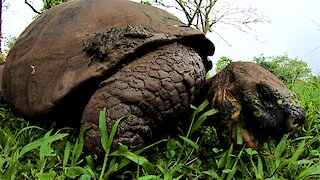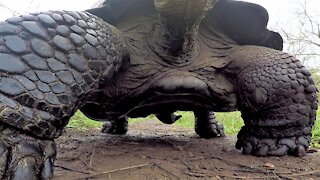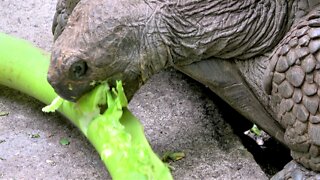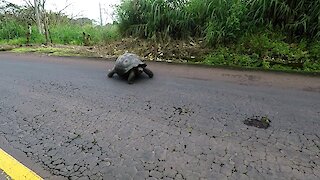Amorous Giant Galapagos Tortoises knock a tree down with their enthusiasm
Giant Galapagos Tortoises are unbelievably large animals. Fully grown, they would fill the passenger compartment of a small car. Weighing up to 227kg (500lb), they are slow moving, but very powerful. These tortoises are believed capable of living up to 200 years. This means that a large specimen like this one might have been alive when Charles Darwin made his famous voyage on the HMS Beagle in 1835, leading him to discoveries that shaped his theories of evolution.
Tortoises lay eggs each year, although few survive, due to their vulnerability when they are young. They cannot outrun even the slowest of predators, and they are not equipped to fight. Their only defense is to retreat inside their thick shells and wait for the predator to tire and leave. Capable of going without food and water for up to one year, they can out-wait any creature on the planet.
What ensures the survival of this species is their longevity. It is only due to the fact that a mature tortoise has so many breeding seasons that it can lay enough eggs for an adequate number to survive the early years.
This enormous male tortoise has found a receptive female partner in the woods on San Cristobal Island. It is a rare sight to see tortoises breeding in the wild. The male lets out loud groaning and grunting sounds that can be heard more than 1.5km (1 mile) away. Their enthusiasm is so great that they don't seem to even notice that a wildlife videographer has quietly followed the sound and taken up a position near them. He arrives just in time to see them knock over a small tree.
The female Galapagos tortoise can carry the sperm with her for as long as four years before she allows her eggs to be fertilized. It will be another six weeks after fertilization before she lays her eggs. She will trek to the coast of the island to find a suitable spot for a nest. Hunted almost to extinction for their meat, these tortoises are slowly making a comeback, largely thanks to protective laws and conservation efforts.
-
 1:54
1:54
WildCreatures
4 years ago $3.06 earnedGiant Tortoises knock over tree with their enthusiasm
2.06K4 -
 1:01
1:01
WildCreatures
4 years ago $5.18 earnedGiant Galapagos Tortoise happily munches away on grass
3.68K3 -
 0:22
0:22
WildCreatures
3 years ago $7.33 earnedGiant Galapagos tortoise knocks over GoPro and films his belly as he passes by
4.48K4 -
 1:16
1:16
KristysWorld
2 years ago $2.18 earnedGiant Galapagos Tortoises Feast On Elephant Ear Stalks
8.48K13 -
 1:36
1:36
WildCreatures
5 years ago $0.53 earnedGalapagos tortoises make world headlines after unbelievable discovery
1.92K2 -
 1:12
1:12
GalapagosGuys
3 years ago $7.38 earnedGiant Galapagos tortoise takes a stroll down bike path
214K84 -
 0:32
0:32
WildCreatures
3 years ago $1.96 earnedGiant Galapagos Tortoise runs over camera left on the trail
6.56K1 -
 1:17
1:17
WildCreatures
2 years ago $8.95 earnedAncient Giant Tortoise Happily Munches In Epic Slow Motion
15.6K71 -
 0:25
0:25
WildCreatures
4 years ago $3.66 earnedGiant wild tortoise gets right of way over traffic in the Galapagos Islands
2.91K4 -
 1:31
1:31
WildCreatures
2 years ago $4.67 earnedGigantic tortoise dives into pond to impress girlfriend
11.8K41